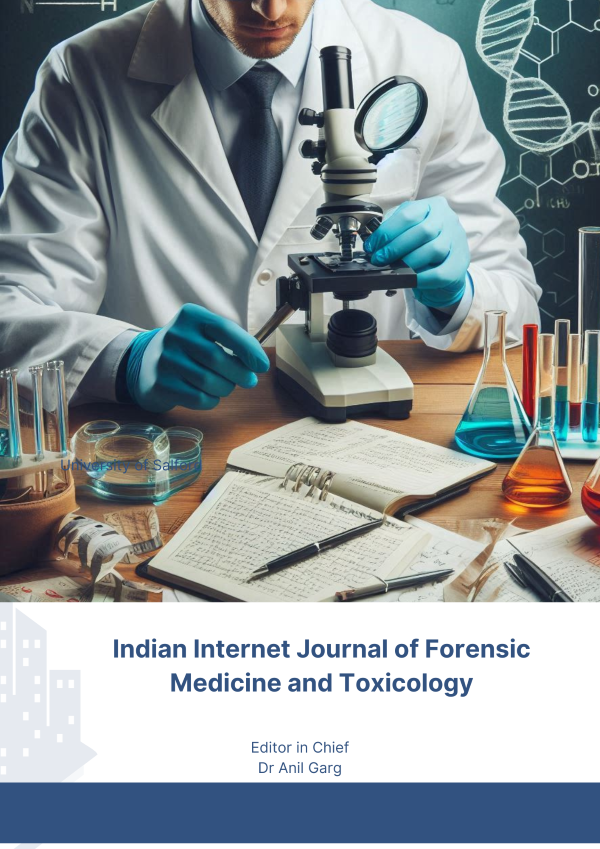Forensic examination of Castor seeds (Ricin): Analytical method develop ment using ALS microscopy, Planar Chromatography and UV-spectroscopy
DOI:
https://doi.org/10.48165/iijfmt.2024.2.2.5Keywords:
Ricin, Castor seeds, Forensic examination, Microscopy of castor seeds, Thin layer chromatography (TLC), UV-visible spectrometry of CastorAbstract
Ricin, a highly toxic protein found in castor bean seeds, is a potential agent for biological warfare and a major concern for national authorities worldwide. The assassination of Georgi Markov using ricin highlighted the forensic importance of detecting this poison. The present study aims to develop an analytical method, to facilitate detection and forensic analysis of ricin. The study employs visual characterization to examine the physical features of the seeds, and thin-layer chromatography (TLC), and UV
visible spectrometry for chemical examination to confirm the presence of ricin. The research design involves conducting solvent extraction and TLC, followed by optical characterization by the use of UV-Vis spectrometry, for quick and unambiguous identification of ricin for forensic purposes. This study reports, for the first time, extensive morphological analysis of castor seeds, green solvent extraction and optimization of TLC. By developing an easy and effective method for the examination of castor seeds and ricin, this study provides a reliable additional test for detecting ricin in castor seeds, which is crucial for forensic and security purposes.
Downloads
References
1. Akande TO, Odunsi AA, Akinfala EO. A review of nutritional and toxicological implications of castor bean (Ricinus com munis L.) meal in animal feeding systems. Journal of animal physiology and animal nutrition. 2016 Apr;100(2):201-10.
2. Sierra MA, Martínez-Álvarez R. Ricin and saxitoxin: Two natu ral products that became chemical weapons. Journal of Chem ical Education. 2020 Jan 3;97(7):1707-14.
3. Yeboah A, Ying S, Lu J, Xie Y, Amoanimaa-Dede H, Boateng KG, Chen M, Yin X. Castor oil (Ricinus communis): a review on the chemical composition and physicochemical properties. Food Science and Technology. 2020 Oct 30;41:399-413.
4. Kaur R, Bhaskar T. Potential of castor plant (Ricinus communis) for production of biofuels, chemicals, and value-added prod ucts. InWaste biorefinery 2020 Jan 1 (pp. 269-310). Elsevier.
5. Bozza WP, Tolleson WH, Rivera Rosado LA, Zhang B. Ricin de tection: Tracking active toxin. Biotechnology Advances. 2015 Jan;33(1):117–23.
6. Schieltz DM, McGrath SC, McWilliams LG, Rees J, Bowen MD, Kools JJ, Dauphin LA, Gomez-Saladin E, Newton BN, Stang HL, Vick MJ. Analysis of active ricin and castor bean proteins in a ricin preparation, castor bean extract, and surface swabs from a public health investigation. Forensic science interna
tional. 2011 Jun 15;209(1-3):70-9.
7. Sousa RB, Lima KS, Santos CG, França TC, Nepovimova E, Kuca K, Dornelas MR, Lima AL. A new method for extraction and analysis of ricin samples through MALDI-TOF-MS/MS. Toxins. 2019 Apr 3;11(4):201.
8. Sejvar JJ. Neurochemical and neurobiological weapons. Neuro logic clinics. 2020 Nov 1;38(4):881-96.
9. Silva BA, Stephan MP, Koblitz MG, Ascheri JL. Influence of NaCl and pH concentration on the extraction of ricin in cas tor bean (Ricinus communis L.) and its characterization by electrophoresis/Influencia da concentracao de NaCl e pH na extracao de ricina em torta de mamona (Ricinus communis L.) e sua caracterizacao por eletroforese. Ciência Rural. 2012 Jul 1;42(7):1320-7.
10. Olsnes S. Toxic proteins inhibiting protein synthesis. Naturwis senschaften. 1972 Nov;59(11):497-502.
11. Kim SK, Hancock DK, Wang L, Cole KD, Reddy PT. Methods to characterize ricin for the development of reference materi als. Journal of Research of the National Institute of Standards and Technology. 2006 Jul;111(4):313.
12. Nelsson R. The Poison-Tipped Umbrella: The Death of Georgi Markov in 1978-Archive. The Guardian. 2020 Sep;9. 13. Sharma S, Kaur G, Kumar A, Singh R. Trends in the analysis of abrin poisoning for forensic purposes. Journal of forensic and legal medicine. 2023 Jul 13:102564.
14. Winder C. Toxicity of ricin. Journal of Toxicology: Toxin Re views. 2004 Jan 1;23(1):97-103.
15. The Facts About Ricin. Ny.gov. 2020. Available from: https:// www.health.ny.gov/environmental/emergency/chemical_ter rorism/ricin.htm
16. Mishra V, Sajeevan A, Das R, Salamun DE. Development of an analytical procedure for the examination of colchicine alka loid (C22H25 NO6) for poisoning cases. International Journal of Medical Toxicology & Legal Medicine. 2023;26(1and2):198- 203.
17. Hameed K, Khan MS, Fatima A, Shah SM, Abdullah MA. Exploring the World of Thin-Layer Chromatography: A Re view. Asian Journal of Applied Chemistry Research. 2023 Oct 17;14(3):23-38.

